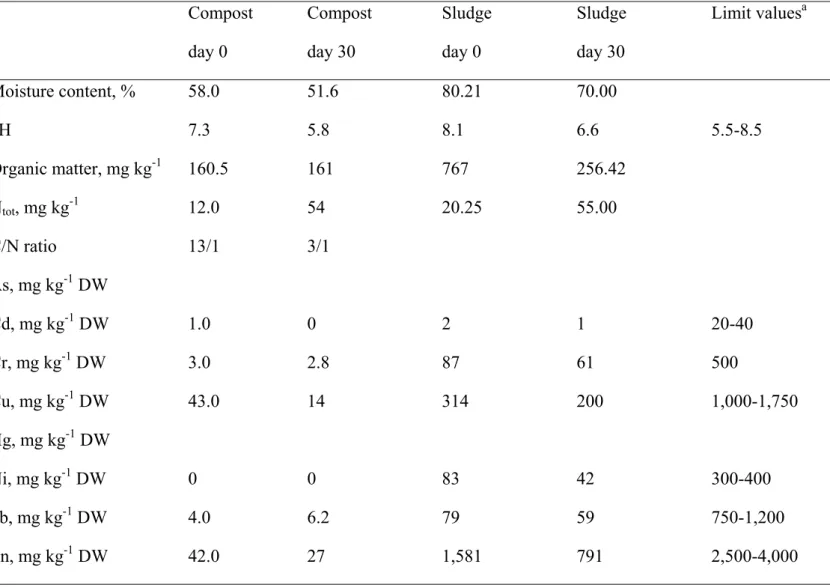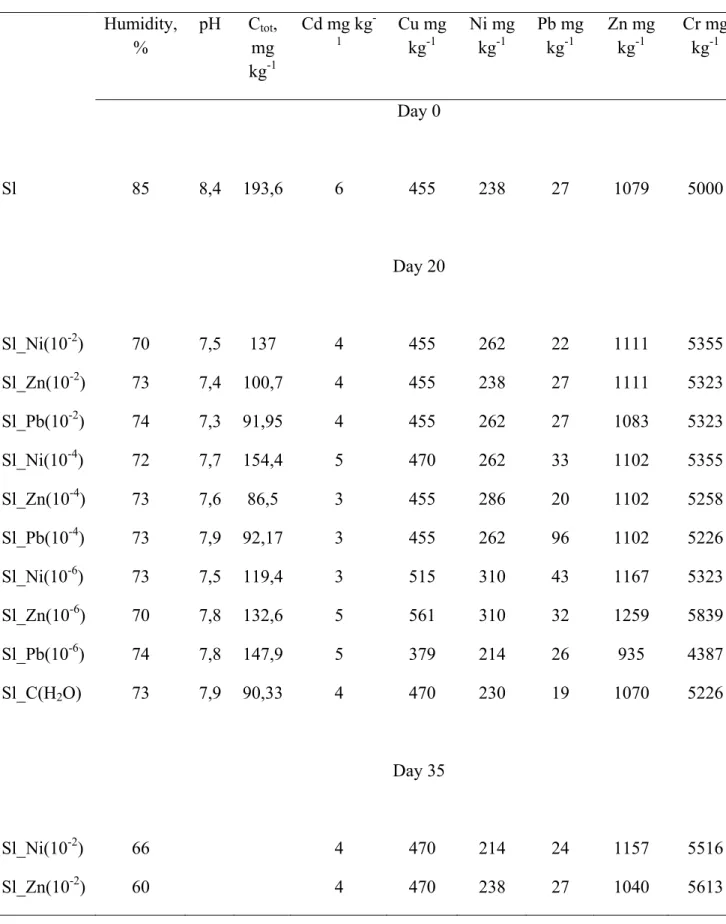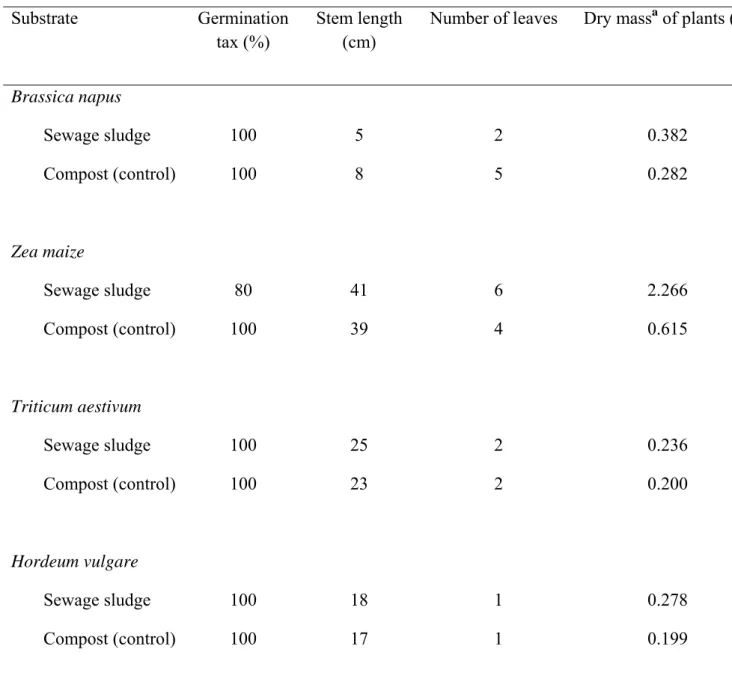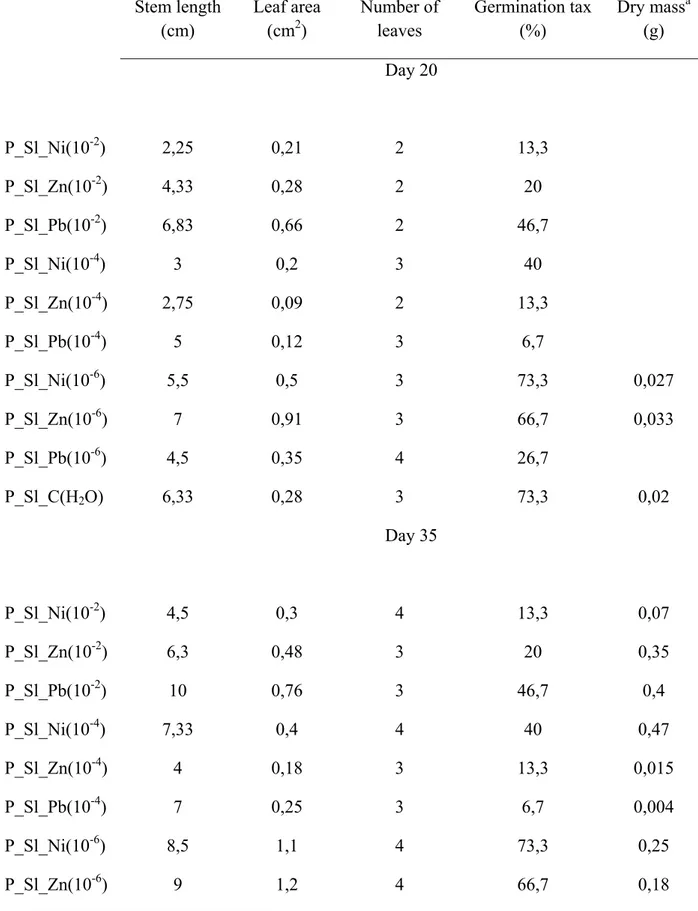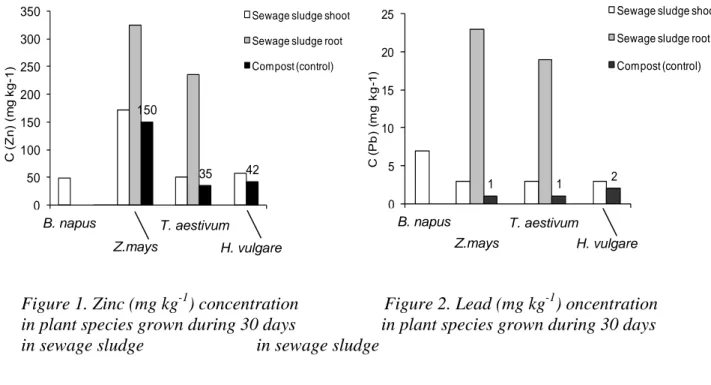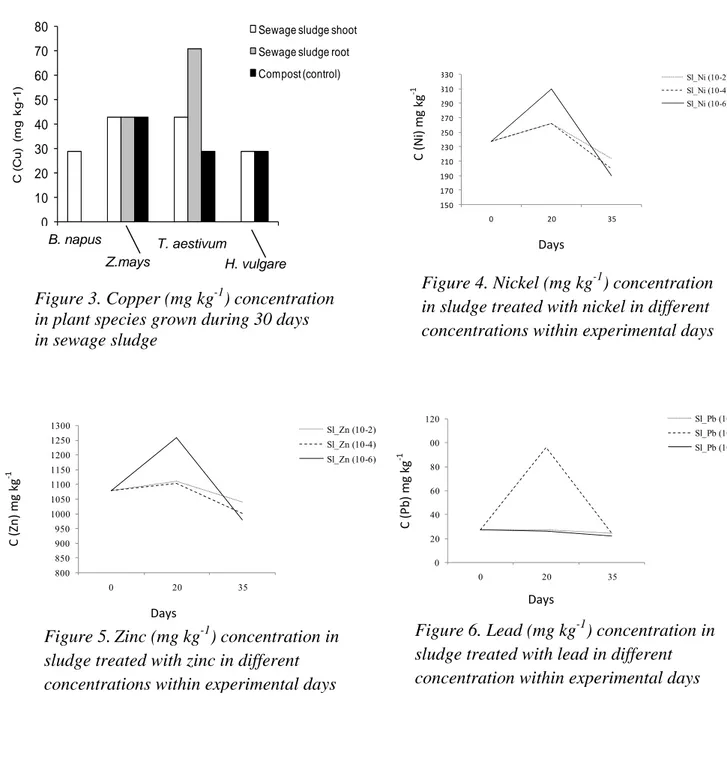PHYTOREMEDIATION AS A PROSPECTIVE
METHOD FOR REHABILITATION OF
AREAS CONTAMINATED BY LONG-TERM
SEWAGE SLUDGE STORAGE: GREEK
EXPERIENCE
N. Suchkova
E. Darakas
J. Ganoulis
Aristotle University of Thessaloniki, Greece
Y. Vergeles
Kharkiv National Academy of Municipal Economy, Ukraine
ABSTRACT
In this work the suitability of several plant species for phytoremediation under natural and artificially installed conditions was studied. Brassica napus, Medicago sativa, Zea
mays, Triticum aestivum, and Hordeum vulgare were grown in pots with sewage sludge
from Sindos Main WWTP in Thessaloniki and from Sindos Industrial WWTP in Thessaloniki, Greece.
The first series of experiments included comparing measurements of various parameters for the above mentioned plants and the sludge to those for control samples (the same plants growing in compost). It was shown that shoot growth was less reduced in T.
aestivum and H. vulgare than in the other plant species studied. B. napus had lower
germination tax, followed by M. sativa with the lowest germination tax. Generally B.
napus, giving less biomass production than Z. mays and T. aestivum, is characterised by
a higher ability to accumulate heavy metals like Cd, Cu, Ni, Pb, Zn, Cr, As and Hg. The second series of experiments included comparing measurements of various parameters of B. napus grown in sludge and treated each 7 days with metal solutions of Ni, Zn and Pb containing 10-2mg/l, 10-4mg/l, 10-6mg/l of each metal, to those for control
plants treated with double distilled water. Results showed that shoot growth of B. napus
were increased at treatments with lower concentrations of metals (10-6 mg/l) and control
(treatment with d-distilled water). At the same time uptake of metal ions was increased with the concentration of the solution, i.e. at higher concentrations (10-2 mg/l). It is truly for Pb and Zn, transfer coefficient TC of which (indicates a plant’s potential to concentrate a metal) was quite high 15 % and 7 % correspondingly. It was noticed that
B. napus has high ability to accumulate Cr, from the other hand it did not accumulate Ni
(at present case). KEYWORDS
1 INTRODUCTION
Sewage sludge (also known as biosolids) is one of the final products of the treatment of sewage at wastewater treatment plant. It usually contains high levels (10 % to >20 %) of organic matter, and is rich in N and P that are essential for plant growth. Its application in agriculture and forestry, resulting in improved soil fertility, has been evaluated in many studies [6, 17]. Sludge also helps maintain soil structure, soil water holding ability, soil cation exchange capacity and soil biological activity [15]. On the other hand, sludge could be contaminated by heavy metals, hydrocarbons or other pollutants removed from the influent wastewater (usually in case, if WWTP treats industrial and mixed industrial and domestic wastewater), which can potentially cause soil pollution and toxic effect on plant growth. This is why in most cases wastewater sludge is not reused and is just left at the area of the WWTP. Thus, in Greece only 10 % of produced sludge is reused in agriculture (for example, at Rethymno WWTP (Chania, Crete) [1, 2, 8, 16, 25]), the rest 90 % is directed to landfills’ disposal [18]. Wastewater sludge could be used not only as a fertilizer; dried sludge could be used in the active cement industry as a fuel substitute. This is especially interesting for WWTPs in Athens and Thessaloniki, where land filling of the sludge can be seriously restricted due to the need for long transportation and the relatively poorer quality of the sludge in terms of fairly high heavy metal concentrations. By the moment the practice of sludge reuse in cement industry has been using in Athens. The next step is expected to be done for Thessalonikis’ WWTPs, where there is no still provision for the reuse of the sludge. The remediation of an area contaminated by sewage sludge storage represents a substantial financial burden for industry, the government and taxpayers. Traditional ex situ remediation efforts (e.g. excavation, burial and contaminant isolation) are not feasible for large-scale impacts and therefore alternative remediation strategies are necessary in cases where vast areas of land have been contaminated. Hyperaccumulator plants, such as Brassica napus (Cr, Cu, Hg, and Pb), Medicago sativa (Cr), Salix spp. (Cr, Zn, and Pb), and Helianthus annuus (Cr, Pb, and Zn) [19, 20, 22], are capable of concentrating trace metals in their harvestable biomass (phytoremediation), thereby offering a sustainable treatment option for metal-contaminated sites [24].
This study focuses on sludge issues at two WWTPs in Thessaloniki, Greece: Sindos Main WWTP and Sindos Industrial WWTP.
Thessaloniki is one of the most densely populated Greek cities with more than 1,000,000 inhabitants. The city is surrounded by several residential communities, while an extended industrial area (Sindos) is located to the North West. Sindos WWTP (in operation since approximately 1983), the main WWTP for the city of Thessaloniki,
receives daily around 150,000-160,000 m3 of wastewater from Thessaloniki’s urban
area via the central sewage system, as well as approximately 1,500 m3/day of
wastewater from areas with hauled waste. About 5-10 % of the total flow comes from industry. The plant also receives the greatest part of the local urban runoff, mainly
surface. The treated wastewater is discharged into the Thermaikos Gulf via a channel. Sewage sludge (primary plus excess activated) is anaerobically digested, thickened, and dewatered with a polyelectrolyte addition in belt filter presses, giving a final product of about 23 % in solids. Dewatered sludge is carried out to a specially designated part of the plant for storage [23]
Sindos Industrial WWTP (in operation since 1978), receives daily around
11,000-18,000 m3 of wastewater (including storm water) from oil refining, petrochemicals,
fertilizers, non-ferrous metal smelting, iron and steel manufacturing, metal recovery
facilities, electrolytic MnO2 production, scrap metal incineration, tyre production and
lubricating oil recovery industries located in industrial area of Sindos [14]. The treated wastewater is discharged into the Thermaikos Gulf via a channel. The volume of sewage sludge (mixture of raw sludge from primary sedimentation tanks and activated sludge from aeration tanks) is about 200 t/day with moisture content is approximately 90 %. It is anaerobically digested, thickened, and dewatered with a polyelectrolyte addition in 4 mechanical centrifuges, giving a final product of about 36 t/day in solids with moisture content is of 17-18 % in solids. Dewatered sludge is carried out to a specially designated part of the plant for storage. By the moment sewage sludge has been storing for 15-20 years approximately.
Taking into account the situation described above, phytoremediation is proposed as a method for rehabilitation of the sites contaminated with sewage sludge storage, application of which expected to be done during sludge reuse, for example, in cement industry or land reclamation. Thus, present work focused on the study of suitability of several plant species for phytoremediation under natural and artificially installed conditions. For this reason Brassica napus, Medicago sativa, Zea mays, Triticum
aestivum and Hordeum vulgare were grown in pots with sludge taken from both the
contaminated areas of the study, i.e. from Sindos Main WWTP and Sindos Industrial WWTP.
2 MATERIALS AND METHODS 2.1 Studied area and material
The first study (Experiment 1) took place in May and June 2008 with the use of dewatered sewage sludge from filter-presses from Sindos Main WWTP, Thessaloniki, Greece. Brassica napus, Medicago sativa, Triticum aestivum, Zea mays and Hordeum
vulgare were grown in pots filled with contaminated media over a 30 day-period. Ten
seeds of each plant species were sown directly into the substrate. The plants were watered regularly during their growing period. Garden compost was used as a control media.
WWTP in Thessaloniki was used as an experimental material. Brassica napus was planted in pots approximately 15 cm wide and 18 cm deep (15 seeds per each pot) filled with the sludge over a 35 day-period. Sludge was treated each 7 days with solutions containing 10-6, 10-4, 10-2 mg/l of nickel (Ni+2), zinc (Zn+2), and lead (Pb+2). Ni and Pb were applied as nitrate and Zn as sulfate. Control was maintained by treatment of the sludge by double distilled water regularly
during the growing period of plants.
Table 1. Characteristics of sewage sludge and compost (inlet data (day 0)) and (outlet data (day 30)) used in Experiment 1 Compost day 0 Compost day 30 Sludge day 0 Sludge day 30 Limit valuesa Moisture content, % pH Organic matter, mg kg-1 Ntot, mg kg-1 C/N ratio As, mg kg-1 DW Cd, mg kg-1 DW Cr, mg kg-1 DW Cu, mg kg-1 DW Hg, mg kg-1 DW Ni, mg kg-1 DW Pb, mg kg-1 DW Zn, mg kg-1 DW 58.0 7.3 160.5 12.0 13/1 1.0 3.0 43.0 0 4.0 42.0 51.6 5.8 161 54 3/1 0 2.8 14 0 6.2 27 80.21 8.1 767 20.25 2 87 314 83 79 1,581 70.00 6.6 256.42 55.00 1 61 200 42 59 791 5.5-8.5 20-40 500 1,000-1,750 300-400 750-1,200 2,500-4,000 As, Hg were not determined.
a86/278/EEC Council Directive on the protection of the environment, and in particular of the soil,
2.2. Analytical methods for sample pretreatment
The chemical analyses were conducted using Standard Methods [21]. In the Experiment 1 sludge/compost samples were taken on days 0, 18 and 30 (see Table 1), and in the Experiment 2 sludge samples were taken on days 0, 20 and 35 (see Table 2), while the plants were growing. The total organic matter and nutrients content in the sludge from Experiment 1 and Experiment 2 were much more than in the control compost used. This sludge contained heavy metals within the permissible limit values [4], and only Zn content was close to the limits. Meanwhile, sludge from Experiment 2 (Industrial WWTP) was contaminated with Cr, the levels of Ni and Zn are near to limit values. The compost from Experiment 1 did not contain any valuable heavy metal concentrations.
Sludge/compost moisture content was determined using Standard ISO 11465 [10] by
gravimetric method based on the weight loss of wet sludge/compost sample at 105◦C; pH was measured potentiometrically in the supernatant suspension of a 1:5 sludge/compost: distilled water (v/v) mixture according to the ISO 10390 [11]; organic matter content was measured on a TOC-5000 (Shimadzu) analyser by ISO 10694 [12, 26]; total nitrogen was determined spectrophotometrically, using a WinLab Data Line photometer (Windaus Labortechnik). The determination of heavy metals in both sludge/compost and the plants samples was carried out by AAS, with flame and graphite furnace modes. A PerkinElmer 503 Atomic Absorption Spectrophotometer was used coupled with a THGA-800 graphite furnace controller. On day 30 of Experiment 1and on days 20 and 35 of Experiment 2, the plants were carefully uprooted, washed thoroughly with water and rinsed with distilled water in order to remove any sludge particles from the substrate. After washing the roots and shoots were separated (only in Experiment 1) and left to dry at room temperature until their weight was constant. Then they were dried in an oven at 65 ◦C for 24 h and further crushed. The wet digestion of organic matrix sampled (plants, sludge, and compost) by use of concentrated and
dissolved HNO3 as the most common procedure was used for sample pretreatment [3].
Table 2. Characteristics of sewage sludge and compost (inlet data (day 0)) and (outlet data (day 20 and 35)) used in Experiment 2
Humidity, % pH Ctot, mg kg-1 Cd mg kg -1 Cu mg kg-1 Ni mg kg-1 Pb mg kg-1 Zn mg kg-1 Cr mg kg-1 Day 0 Sl 85 8,4 193,6 6 455 238 27 1079 5000 Day 20 Sl_Ni(10-2) Sl_Zn(10-2) Sl_Pb(10-2) Sl_Ni(10-4) Sl_Zn(10-4) Sl_Pb(10-4) Sl_Ni(10-6) Sl_Zn(10-6) Sl_Pb(10-6) Sl_C(H2O) 70 73 74 72 73 73 73 70 74 73 7,5 7,4 7,3 7,7 7,6 7,9 7,5 7,8 7,8 7,9 137 100,7 91,95 154,4 86,5 92,17 119,4 132,6 147,9 90,33 4 4 4 5 3 3 3 5 5 4 455 455 455 470 455 455 515 561 379 470 262 238 262 262 286 262 310 310 214 230 22 27 27 33 20 96 43 32 26 19 1111 1111 1083 1102 1102 1102 1167 1259 935 1070 5355 5323 5323 5355 5258 5226 5323 5839 4387 5226 Day 35 Sl_Ni(10-2) Sl_Zn(10-2) 66 60 4 4 470 470 214 238 24 27 1157 1040 5516 5613
dry weight) was placed in a Teflon beaker. About 20 ml of concentrated HNO3 was
added to each beaker and the mixture was covered with a lid. This was then left at room temperature for 24 h. Afterwards it was heated to near dryness on a sand bath,
subsequently dissolved in 20 ml 1 + 1 HNO3 and was heated on a sand bath for exactly
30 min. The residue was diluted to 200 ml with d-distilled water (the beakers were also washed twice with d-distilled water), and the final solutions were analyzed for determining concentrations of metals — Cd, Cu, Ni, Pb, Zn, and Cr. In addition, on the
30th and 35th days of the two experiments correspondingly the dry mass of plants and
the biometric parameters (germination tax, stem length and number of leaves) were measured (see Table 3, 4). Dry mass was established after drying the plant material in an oven at 65 ◦C for 24 h [13]. Sl_Pb(10-2) Sl_Ni(10-4) Sl_Zn(10-4) Sl_Pb(10-4) Sl_Ni(10-6) Sl_Zn(10-6) Sl_Pb(10-6) Sl_C(H2O) 63 61 61 61 62 62 63 72 4 4 4 4 4 4 5 4 455 455 455 439 485 485 485 485 238 200 238 238 190 190 262 220 24 20 20 24 19 21 22 17 1134 1102 1000 1065 1120 980 1157 1000 5403 5323 5484 5097 5161 5242 5387 5484
pH, organic matter Ctot were not determined on day 35 of the experiment
Nomenclature: Sl – sludge; 10-2, 10-4, 10-6 – sludge treatment with Ni, Zn and Pb containing 0,01;
Table 3. Dry mass and biometric characteristics (mean, n=10) of selected plants grown at contaminated media on day 30 in Experiment 1
Substrate Germination
tax (%)
Stem length (cm)
Number of leaves Dry massa of plants (g)
Brassica napus Sewage sludge Compost (control) 100 100 5 8 2 5 0.382 0.282 Zea maize Sewage sludge Compost (control) 80 100 41 39 6 4 2.266 0.615 Triticum aestivum Sewage sludge Compost (control) 100 100 25 23 2 2 0.236 0.200 Hordeum vulgare Sewage sludge Compost (control) 100 100 18 17 1 1 0.278 0.199
a Number of plants sampled for dry mass measurements differs from plant to plant and substrate (B.
napus in sludge and compost n=5; Z. mays in sludge n=3, Z. mays in compost n=1; T. aestivum in
Table 4. Dry mass and biometric characteristics of B. napus plants grown at contaminated media on days 20 and 35 in Experiment 2
Stem length (cm) Leaf area (cm2) Number of leaves Germination tax (%) Dry massa (g) Day 20 P_Sl_Ni(10-2) 2,25 0,21 2 13,3 P_Sl_Zn(10-2) 4,33 0,28 2 20 P_Sl_Pb(10-2) 6,83 0,66 2 46,7 P_Sl_Ni(10-4) 3 0,2 3 40 P_Sl_Zn(10-4) 2,75 0,09 2 13,3 P_Sl_Pb(10-4) 5 0,12 3 6,7 P_Sl_Ni(10-6) 5,5 0,5 3 73,3 0,027 P_Sl_Zn(10-6) 7 0,91 3 66,7 0,033 P_Sl_Pb(10-6) 4,5 0,35 4 26,7 P_Sl_C(H2O) 6,33 0,28 3 73,3 0,02 Day 35 P_Sl_Ni(10-2) 4,5 0,3 4 13,3 0,07 P_Sl_Zn(10-2) 6,3 0,48 3 20 0,35 P_Sl_Pb(10-2) 10 0,76 3 46,7 0,4 P_Sl_Ni(10-4) 7,33 0,4 4 40 0,47 P_Sl_Zn(10-4) 4 0,18 3 13,3 0,015 P_Sl_Pb(10-4) 7 0,25 3 6,7 0,004 P_Sl_Ni(10-6) 8,5 1,1 4 73,3 0,25 P_Sl_Zn(10-6) 9 1,2 4 66,7 0,18
P_Sl_Pb(10-6) 6,4 0,6 6 26,7 0,05
P_Sl_C(H2O) 9,3 0,5 5 73,3 0,33
3 RESULTS
3.1 Growth and heavy metal uptake 3.1.1 Experiment 1
The seed germination rates of five plant species in contaminated media compared to control is shown in Table 3. Germination rate of B. napus, Z. mays, T. aestivum and H.
vulgare in both the control substrates (compost) and in the sludge in the Experiment 1
was high, about 100 %, while the growth of M. sativa was close to 0%. In general, it was noticed the higher accumulation of all the metals in root parts of the plants. Thus, T.
aestivum showed good results in accumulation (in mg kg-1 DW) of Cu (71) and Ni (42)
in comparison to the control plants, while Z. mays had a better accumulation of (in mg
kg-1 DW) Pb (23) and Zn (325) (see Figures 1–3).
3.2.2 Experiment 2
The seed germination rates of B. napus in contaminated media compared to control is shown in Table 4. In the Experiment 2, where plants’ metal treatment had place, it is obvious that germination tax increases in the pots with plants treated with lower
concentration of metals (10-6 mg/l) and control (treated with d-distilled H2O). This is
truly for Zn and Ni, where germination tax of B napus reached 70 % comparing to 13 %
and 20 % at concentration 10-2 mg/l of Ni and Zn correspondingly. However, Pb had
back effect on the germination rate, which is higher in plants treated with higher
concentrations (10-2 mg/l) and reached 50 % comparing to germination tax of 7 % and
27 % at concentrations 10-4 and 10-6 mg/l of Pb.
B. napus stem length was affected by heavy metal application. Plants grown up at low
Zn and Ni concentrations had increase in average stem length in comparison to the plants grown up at high concentrations of the same metals, whereas Pb increased the growth rate at its concentration 10-2 mg/l.
Heavy metals uptake was different depending on the element application as well as on their concentration. In general the uptake of Zn at higher concentrations of three
investigated metals was higher. Thus, Zn (74 mg kg-1 DW), (65 mg kg-1 DW) and (144
mg kg-1 DW) at Zn, Pb and Ni treatment with concentration 10-2 mg/l of metal
correspondingly, whereas Zn (69 mg kg-1 DW), (93 mg kg-1 DW) and (0 mg kg-1 DW)
applied to the sludge. Thus, Pb (6 mg kg-1 DW) at 10-2 mg/l of Pb, whereas Pb (0 mg kg-1 DW) at 10-6 mg/l of Pb. B. napus did not accumulate Ni.
B. napus showed good accumulation of Cr in all metals’ treatment and it was: Cr (194
mg kg-1 DW), (145 mg kg-1 DW) and (565 mg kg-1 DW) at treatment, containing 10-2
mg/l of Zn, Pb and Ni correspondingly; Cr (177 mg kg-1 DW), (323 mg kg-1 DW), and
(81 mg kg-1 DW) at treatment, containing 10-6 mg/l of Zn, Pb and Ni correspondingly.
4 DISCUSSION
Methods for evaluating the presence of heavy metals are based on the amount of the element absorbed by the plant in correlation with growth and biomass productivity. These relationships are dependent on characteristics of the soil, the sludge, and the species used.
In order to estimate the transfer of heavy metals from the sludge to the plants several traditional parameters were used [15, 24]: transfer coefficient (TC; i.e. the percentage of metals transferred from the sludge to the shoots (leaves)), which indicates a plant’s potential to concentrate a metal and translocation factor (TF; i.e. the ratio of metal concentration in shoot tissue to metal concentration in root tissue), which estimates the translocation efficiency of a plant; TF for a hyperaccumulators is typically > 1.
Table 5. TC and TF of heavy metals for different plant species from both experiments Experiment 1 Experiment 2 TC (%) TF TC (%) Cu Cu in B. napus Brassica napus Medicago sativa Zea mays Triticum aestivum Hordeum vulgare 9.2 13.7 13.7 9.2 1 0.6 P_Sl_Ni(10-4) 13.4 Pb Pb in B. napus Brassica napus 8.9 P_Sl_Pb(10-2) 25 Medicago sativa 0 P_Sl_Ni(10-4) 5 Zea mays 3.8 0.1 P_Sl_Ni(10-6) 26.3 Triticum aestivum 3.8 0.2 P_Sl_Zn(10-6) 9.5 Hordeum vulgare 3.8 P_Sl_Pb(10-6) 0 P_Sl_C(H2O) 41.2 Zn Zn in B. napus Brassica napus 3 P_Sl_Zn(10-2) 7.1 Medicago sativa 0 P_Sl_Pb(10-2) 5.7
Zea mays 10.8 0.5 P_Sl_Ni(10-4) 13.1 Triticum aestivum 3.2 0.2 P_Sl_Ni(10-6) 0 Hordeum vulgare 3.7 P_Sl_Zn(10-6) 7
P_Sl_Pb(10-6) 8
Cr Cr in B. napus Brassica napus 13.8 P_Sl_Zn(10-2) 3.5 Medicago sativa P_Sl_Pb(10-2) 2.7 Zea mays 4.6 0.7 P_Sl_Ni(10-4) 10.6 Triticum aestivum 3.4 0.2 P_Sl_Ni(10-6) 1.6 Hordeum vulgare 4.6 P_Sl_Zn(10-6) 3.4
P_Sl_Pb(10-6) 6
P_Sl_C(H2O) 5
The TC of metals was different depending on the plant species as well as on the element analyzed (see Table 5).
In both experiments Brassica napus had quite high TC values in comparison to other species, followed by Zea mays, Triticum aestivum, and Hordeum vulgare (for the Experiment 1). In the first experiment Cu was the most transferable, with TC values of between 9 % and 13 %, followed by Cr, Zn, and Pb, while in the second experiment Pb was the most transferable.
The distribution of the metals within the shoots and roots was different: Cu, Zn and Cr were found in the shoots, while the greatest amount of Pb was observed in the roots (the lowest TF).
In the Experiment 2 in general at all treatments (10-2-10-6 mg/l) B. napus actively
accumulated Pb, Zn and Cr. The highest TC values were found for the Pb. So, Pb, with average TC value of 15 %, was the most transferable, followed by Zn, with average TC value of 7 %, and Cr, with average TC value of 4 %. Cd and Cu were the least transferable. In the present research Ni was not accumulated by B. napus.
What is more, Pb accumulated in higher extent at treatment with Pb in higher
concentration (10-2 mg/l) (TC=25 %), whereas at treatment with Pb in low concentration
(10-6 mg/l) accumulation was negligible (TC=0).
Present research was carried out over a 35 day period. It was noticed that during the first 20 days of active sludge treatment with heavy metals, their concentrations in the substrate increased in comparison with the initial concentrations (day 0), however, on day 35 their concentrations were found less than on day 0 (see Figures 4-7). At the same time concentrations of heavy metals in B. napus plants on day 35 in comparison with on day 20 were higher. This could be explained by following: during the first 20 days of experiment there was no enough biomass produced by plants and able to accumulate metals. With the plants growth and development (closer to day 35) metals concentration in substrate started to decrease due to their accumulation in the plants. The concentration of metals in substrate treated with d-distilled water (control) slowly
In both experiments the sludge treatment with heavy metals did not cause phytotoxicity symptoms in the plants. Chaney [7] and Environment Canada [9] have indicated the range of toxicity levels for some metals in leaf tissues for various species to be as follows: Cd, 5 to 700; Cu, 25 to 40; Ni, 50 to 100; Zn, 500 to 1500; Pb, 30 to 300 mg
kg-1 DW. The maximum plants (shoot and roots) metal concentrations recorded in the
experiment were below these levels. Moreover, there was not noticed any chlorosis or necrosis effects on the plants.
5 CONCLUSIONS
We intended on searching the most suitable plants for phytoremediation in cases of Sindos Main WWTP and Sindos Industrial WWTP in Thessaloniki, Greece, application of which expected to be done after the process of sludge reuse will begin. Using five plant species both the capacity of the plants to accumulate metals in their parts and the plants’ tolerance to metals (especially in the Experiment 2) were studied. It can be concluded that sludge, rich in organic matter, is a good medium for all plant species, giving a high biomass production.
From the both experiments it could be concluded that Brassica napus had a good capacity to tolerate and accumulate metals. None of the plant species showed any symptoms of toxicity due to the absorption of heavy metals.
Figure 1. Zinc (mg kg-1) concentration Figure 2. Lead (mg kg-1) oncentration in plant species grown during 30 days in plant species grown during 30 days in sewage sludge in sewage sludge
150 35 42 0 50 100 150 200 250 300 350 1 C (Z n ) (m g k g -1 )
Sewage sludge shoot Sewage sludge root Compost (control) B. napus Z.mays T. aestivum H. vulgare 1 1 2 0 5 10 15 20 25 1 C (P b ) (m g k g -1 )
Sewage sludge shoot
Sewage sludge root Compost (control)
B. napus Z.mays
T. aestivum
Figure 3. Copper (mg kg-1) concentration in plant species grown during 30 days in sewage sludge 0 10 20 30 40 50 60 70 80 1 C (C u ) (m g k g -1)
Sewage sludge shoot Sewage sludge root Compost (control) B. napus Z.mays T. aestivum H. vulgare 150 170 190 210 230 250 270 290 310 330 0 20 35 Sl_Ni (10-2) Sl_Ni (10-4) Sl_Ni (10-6) Days C (Ni ) mg kg ‐1
Figure 4. Nickel (mg kg-1) concentration in sludge treated with nickel in different concentrations within experimental days
Figure 6. Lead (mg kg-1) concentration in sludge treated with lead in different concentration within experimental days
0 20 40 60 80 100 120 0 20 35 Sl_Pb (10-2) Sl_Pb (10-4) Sl_Pb (10-6) Days C (Pb ) mg kg ‐1
Figure 5.Zinc (mg kg-1) concentration in sludge treated with zinc in different concentrations within experimental days
800 850 900 950 1000 1050 1100 1150 1200 1250 1300 0 20 35 Sl_Zn (10-2) Sl_Zn (10-4) Sl_Zn (10-6) Days C (Zn) mg kg ‐1 0 200 400 600 800 1000 1200 0 20 35 Sl_C (d-dist.H2O)-Ni Sl_C (d-dist.H2O)-Pb Sl_C (d-dist.H2O)-Zn Days C (metal ) mg kg ‐1
In the Experiment 1 it was shown that the highest concentration of metals is in the plants, grown in sludge (in comparison to the control compost) and in their root parts (in comparison to their shoot parts). Thus, huge amounts of Pb were found in the roots of the plants. The accumulation of metals in roots would in effect immobilize the metals for a certain period of time, therefore reducing risks of contamination by inhibiting the circulation of these pollutants in the environment. This is important for perennial plants. On the other hand, for B. napus, Z. mays and T. aestivum, which are the annual plants, metal accumulation in the leaf area is referable. In the case of their use for phytoremediation the utilization of leaves rich in heavy metals has to be organized at the end of the harvest season.
In the Experiment 2, where sludge with the plants were treated with heavy metals solutions, containing 10-6, 10-4, 10-2 mg/l of nickel (Ni+2), zinc (Zn+2), and lead (Pb+2), was found the following: if shoot growth of B. napus were increased at treatments with
lower concentrations of metals (10-6 mg/l) and control (treatment with d-distilled water),
the uptake of metal ions was increased at treatments with higher concentrations (10-2
mg/l).
It was determined that the order of transferability of the metallic ions was as follows: Pb and Zn with transfer coefficient TC 15 % and 7 % being the most transferable, then Cr and Cd. Ni was not accumulated by the plants at all (at the present case).
At the present stage there is not enough knowledge concerning the mechanisms of metal tolerance and accumulation in the selected plant species. However, it can already be concluded from the results of both experiments, which were rather complementary than different, that B. napus could be good candidate for phytoremediation of contaminated areas.
REFERENCES
[1] Andreadakis, A.D., Mamais, D., Gavalaki, E., Kampylafka, S., 2002. Sludge Utilisation in Agriculture: Possibilities and Prospects in Greece, Wat.Sci.Tech., 46, (10), 231-238.
[2] Andreadakis, A.D. From the project “Hygienic management of sludge for agricultural utilization (SMAG), 1997-2001”.
[3] Bock, R., 1979. In: Marr, I. (Ed.), A Handbook of Decomposition Methods in Analytical Chemistry. International Textbook Co., Great Britain, pp. 201–222. [4] 86/278/EEC. Council Directive of 12 June 1986 Concerning the protection of the
environment, and in particular of the soil, when sewage sludge is used in agriculture.
[5] 91/271/EEC. Council Directive f 30 May 1991 concerning urban wastewater treatment.
[6] Cheng, H., Xu, W., Liu, J., Zhao, Q., He, Y., Chen, G., 2007. Application of composted sewage sludge (CSS) as a soil amendment for turfgrass growth. Ecol. Eng. 29, 96-104.
[8] Christoulas, G., Andreadakis, D., Kouzeli-Katsiri, A., Aftias, E., Mamais, D., 2000. Alternative schemes the management of the sludge produced at Psyttalia WWTP". Wat.Sci.Tech. 42, (9), 29-36.
[9] Environment Canada, 1985. L’epandage des eaux usees traitees et des boues d’epuration d’origine urbaine. Guide SPE 6-EP-84-1. Diraction Generale des programmes de protection de I’environment, 190.
[10] ISO 11465:1993. Soil quality-Determination of dry matter and water content on a mass basis-Gravimetric method.
[11] ISO 10390:2005. Soil quality-Determination of pH.
[12] ISO 10694:1995. Soil quality-Determination of organic and total carbon after dry combustion (elementary analysis).
[13] Ivanova, V., Vassilev, A., 2002. Biometric and physiological characteristics of Chrysanthemum (Chrysanthemum Indicum L.) plants grown at different rates of Nitrogen fertilization. Journal of Central European Agriculture ISSN 1332-9049 [14] Katsoyiannis, A., Samara, C., 2004. Persistent organic pollutants (POPs) in the
sewage treatment plant of Thessaloniki, northern Greece: occurrence and removal. Water Res. 38 (11), 2685-2698.
[15] Labrecque, M., Teodorescu, T.I., and Daigle, S., 1995. Effect of wastewater sludge on growth and heavy metal bioaccumulation of two Salix species. Plant Soil 171, 303-316.
[16] Mamais, D., Kouzeli-Katsiri, A., Christoulas, G., Andreadakis, D., Aftias, E., 2000. Evaluation of agricultural utilisation of the sludge produced at Psyttalia WWTP", Wat.Sci.Tech. 42, (9), 21-28.
[17] Manios, T., Stentiford, E., Millner, P., 2003. The effect of heavy metals accumulation on the chlorophyll concentration of Typha latifolia plants, growing in a substrate containing sewage sludge compost and watered with metaliferus water. Ecol. Eng. 20, 65-74.
[18] Matthews, P., 1999. A global atlas of wastewater sludge and biosolids use and disposal. Scientific and technical report No 4 – Vol. 197.
[19] McCutcheon, S., Schnoor, 2003. Phytoremediation. New Jersey, John Wiley&Sons, pp. 19.
[20] Memon, A.R., Aktoprakligil, D., Ozdemir, A., 2001. Heavy metal accumulation and detoxification mechanisms in plants. Turk. J. Bot., 111–121.
[22] Pulford, I.D., Watson, C., 2003. Phytoremediation of heavy metal-contaminated land by trees—a review. Environ. Int. 29, 529–540.
[23] Suchkova, N., Darakas, E., Ganoulis, J., 2010. Phytoremediation as a prospective method for rehabilitation of areas contaminated by long-term sewage sludge storage: A Ukrainian-Greek case study. Ecol. Eng. 36, 373-378.
[24] Tappero, R., Peltier, E., Grafe, M., 2007. Hyperaccumulator Alyssum murale relies on a different metal storage mechanism for cobalt than for nickel. New Phytologist 175, 641-654.
[25] Tsagarakis, K., 2007. Optimal number of energy generators for biogas utilization in wastewater treatment facility. En Con Man 48, 2694-2698.
[26] Vandecasteele, B., Samyn, J., Bruno De Vos, Muys, B., 2008. Effect of tree species choice and mineral capping in a woodland phytostabilization system: a case study for calcareous dredged sediment landfills with an oxidised topsoil. Ecol. Eng. 32, 263–273
